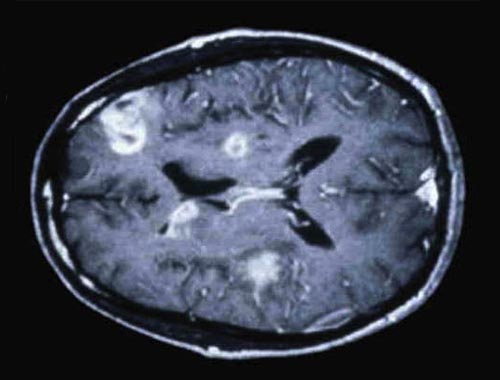Brain Tumor, Primary CNS (Non-Hodgkin) lymphoma

Published: 18 Jun 2025
ICD9: 202.8 ICD10: C85.80 ICD11: 2A00.5
"Brain Tumor, Primary CNS (Non-Hodgkin) Lymphoma" is a specific type of brain tumor that originates within the central nervous system (CNS) and is a type of Non-Hodgkin Lymphoma.
Let's break that down:
![]() Brain Tumor: This means an abnormal growth or mass within the brain. However, Primary CNS Lymphoma is *not* like typical brain tumors that arise from brain cells themselves (like gliomas).
Brain Tumor: This means an abnormal growth or mass within the brain. However, Primary CNS Lymphoma is *not* like typical brain tumors that arise from brain cells themselves (like gliomas).
![]() Primary CNS: This is crucial. "Primary" means that the lymphoma starts in the brain and/or spinal cord (the central nervous system). It is *not* lymphoma that has spread (metastasized) to the brain from somewhere else in the body.
Primary CNS: This is crucial. "Primary" means that the lymphoma starts in the brain and/or spinal cord (the central nervous system). It is *not* lymphoma that has spread (metastasized) to the brain from somewhere else in the body.
![]() (Non-Hodgkin) Lymphoma: This is a cancer of the lymphatic system, a part of the immune system. Lymphomas are broadly divided into Hodgkin lymphoma and Non-Hodgkin lymphoma. Primary CNS lymphomas are almost always Non-Hodgkin lymphoma. In this case, abnormal lymphocytes (a type of white blood cell) grow and multiply uncontrollably within the CNS.
(Non-Hodgkin) Lymphoma: This is a cancer of the lymphatic system, a part of the immune system. Lymphomas are broadly divided into Hodgkin lymphoma and Non-Hodgkin lymphoma. Primary CNS lymphomas are almost always Non-Hodgkin lymphoma. In this case, abnormal lymphocytes (a type of white blood cell) grow and multiply uncontrollably within the CNS.
Key Characteristics and Important Points:
![]() Rare: Primary CNS lymphomas are relatively rare, accounting for a small percentage of all brain tumors and Non-Hodgkin lymphomas.
Rare: Primary CNS lymphomas are relatively rare, accounting for a small percentage of all brain tumors and Non-Hodgkin lymphomas.
![]() Aggressive: They are generally considered aggressive lymphomas, meaning they can grow and spread quickly within the CNS.
Aggressive: They are generally considered aggressive lymphomas, meaning they can grow and spread quickly within the CNS.
![]() Location: They can occur in various locations within the brain and spinal cord, including the cerebrum, cerebellum, brainstem, and meninges (membranes surrounding the brain and spinal cord).
Location: They can occur in various locations within the brain and spinal cord, including the cerebrum, cerebellum, brainstem, and meninges (membranes surrounding the brain and spinal cord).
![]() Immunocompromised Individuals: While it can occur in anyone, it's more common in people with weakened immune systems, such as those with HIV/AIDS, organ transplant recipients taking immunosuppressants, or those with certain autoimmune diseases. However, the majority of cases occur in people with no known immunodeficiency.
Immunocompromised Individuals: While it can occur in anyone, it's more common in people with weakened immune systems, such as those with HIV/AIDS, organ transplant recipients taking immunosuppressants, or those with certain autoimmune diseases. However, the majority of cases occur in people with no known immunodeficiency.
![]() Diagnosis: Diagnosis typically involves a brain biopsy to confirm the presence of lymphoma cells. MRI scans are also essential for visualizing the tumor(s) and assessing the extent of the disease. Lumbar puncture (spinal tap) is often performed to check for lymphoma cells in the cerebrospinal fluid (CSF).
Diagnosis: Diagnosis typically involves a brain biopsy to confirm the presence of lymphoma cells. MRI scans are also essential for visualizing the tumor(s) and assessing the extent of the disease. Lumbar puncture (spinal tap) is often performed to check for lymphoma cells in the cerebrospinal fluid (CSF).
![]() Treatment: Treatment typically involves high-dose chemotherapy, often followed by radiation therapy. The specific treatment plan will depend on the individual's health, the stage of the lymphoma, and other factors. Targeted therapies and immunotherapies are also being investigated.
Treatment: Treatment typically involves high-dose chemotherapy, often followed by radiation therapy. The specific treatment plan will depend on the individual's health, the stage of the lymphoma, and other factors. Targeted therapies and immunotherapies are also being investigated.
![]() Prognosis: The prognosis (outlook) for primary CNS lymphoma has improved significantly with advancements in treatment. However, it can still be a challenging cancer to treat, and the outcome varies depending on individual factors. Relapse (the cancer coming back) is possible.
Prognosis: The prognosis (outlook) for primary CNS lymphoma has improved significantly with advancements in treatment. However, it can still be a challenging cancer to treat, and the outcome varies depending on individual factors. Relapse (the cancer coming back) is possible.
In Summary:
Think of "Brain Tumor, Primary CNS (Non-Hodgkin) Lymphoma" as:
![]() Where: Cancer starting *in* the brain and/or spinal cord.
Where: Cancer starting *in* the brain and/or spinal cord.
![]() What: A type of cancer of immune cells (lymphocytes) within the CNS.
What: A type of cancer of immune cells (lymphocytes) within the CNS.
![]() How Serious: Usually aggressive, but treatable with chemotherapy and other therapies.
How Serious: Usually aggressive, but treatable with chemotherapy and other therapies.
Important Disclaimer: This information is for general knowledge and understanding only, and does not constitute medical advice. If you have concerns about your health, please consult with a qualified healthcare professional for diagnosis and treatment.